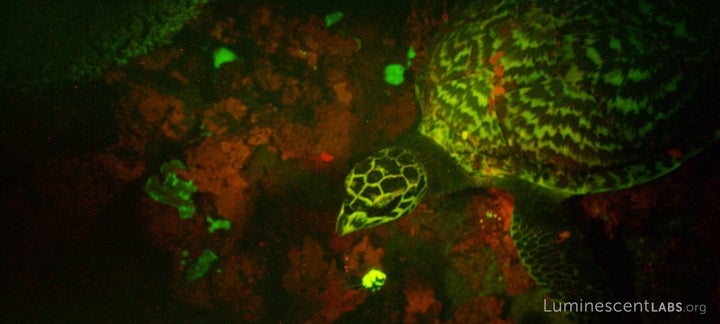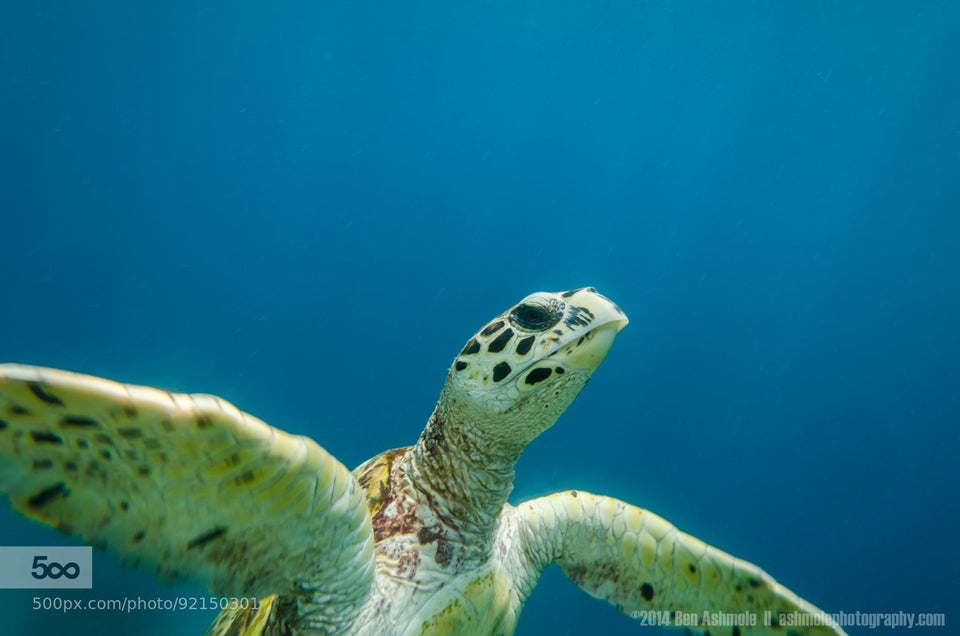Marine biologist David Gruber didn’t plan to find a glowing sea turtle, but he’s glad he did.
The associate professor of biology at City University of New York was diving in the Solomon Islands in July doing research on biofluorescence -- an animal’s ability to absorb certain types of light, then re-emit that light as a different color -- in small sharks and coral reefs. This transformation is made possible through the presence of special proteins, Gruber said.
Animals that exhibit biofluorescence typically absorb and transform blue light, meaning that their neon patterns are visible deep in the ocean, where blue light is plentiful. Gruber and his team were using special camera equipment that enhances the blue light, making glowing colors stand out even more, he told The Huffington Post.
The researcher told National Geographic that he and other divers were keeping watch for crocodiles when the neon reptile “came out of nowhere.”

The green and red animal was a hawksbill sea turtle, an endangered species that lives in tropical and subtropical waters around the globe. The turtles are hunted for their flesh and their shell, which is sold for jewelry and other decorative items, and people around the world also consume the turtle’s eggs. Gruber noted that hawksbills are additionally threatened by the fishing industry, since they end up as bycatch, and by climate change.
To ensure that the glow was a species-wide phenomenon, and not just something odd going on with one turtle, Gruber located some hawksbills kept in captivity.
“We basically took those turtles and shined the blue lights on them,” he said. All of them had the neon colors of the turtle Gruber spotted while diving.
So how did nobody notice these glowing turtles before? In shallow water, Gruber explained, there’s not enough blue light to create the “glow” effect. That’s why researchers had to bathe the captive turtles in blue light in order to produce the neon red and green colors.
Gruber also tested the lights on a loggerhead sea turtle at an aquarium, and said that turtle exhibited biofluorescence as well. But, he added, he hasn’t done enough research to make any definitive statements about loggerheads.
While Gruber’s find marks the official “discovery” of biofluorescence in turtles, he suspects others have noticed the phenomenon before and just not realized what they were seeing.
“There have been a few photos with a turtle showing this fluorescence, but [the photographers] thought there was something wrong with their camera,” Gruber said.
It’s too early to say what purpose the neon colors serve for hawkbill turtles, but Gruber has some guesses.
“The one thing that we know is that the males and females have slightly different patterns,” he said. “It could be used for mating and [helping] the turtles find each other. It could be used to camouflage themselves hanging out among other fluorescent animals.”
He also noted that “we don’t know anything about the vision of the turtle,” so it’s difficult to assess exactly how biofluorescence looks to a sea turtle’s eye. Gruber hopes the new discovery fuels more research into hawksbill sea turtles and ocean life in general.
“Why is it that we know so little about these amazing animals?” he asked.
Contact the author of this article at Hilary.Hanson@huffingtonpost.com.

